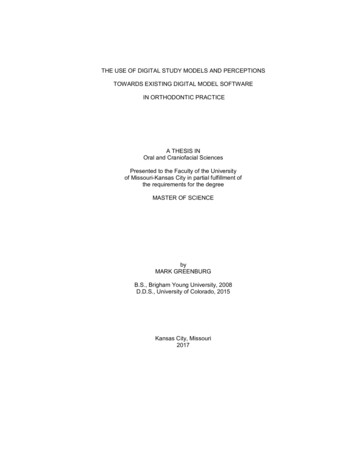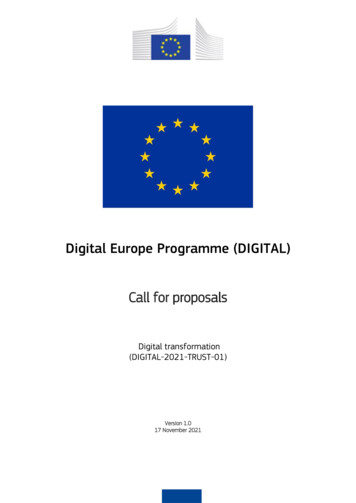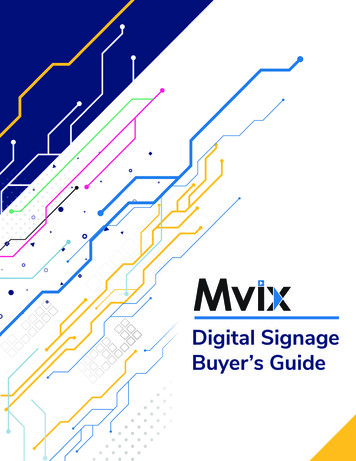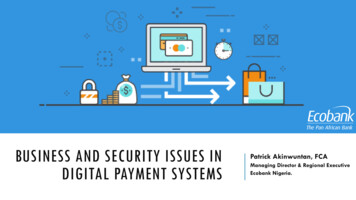
Transcription
THE USE OF DIGITAL STUDY MODELS AND PERCEPTIONSTOWARDS EXISTING DIGITAL MODEL SOFTWAREIN ORTHODONTIC PRACTICEA THESIS INOral and Craniofacial SciencesPresented to the Faculty of the Universityof Missouri-Kansas City in partial fulfillment ofthe requirements for the degreeMASTER OF SCIENCEbyMARK GREENBURGB.S., Brigham Young University, 2008D.D.S., University of Colorado, 2015Kansas City, Missouri2017
THE USE OF DIGITAL STUDY MODELS AND PERCEPTIONSTOWARDS EXISTING DIGITAL MODEL SOFTWAREIN ORTHODONTIC PRACTICEMark Greenburg, Candidate for the Master of Science DegreeUniversity of Missouri-Kansas City, 2017ABSTRACTThe purpose of this project was to determine what demographic factors, if any, lead to privatepractice orthodontists creating digital models and then taking the additional step of using thesemodels in treatment planning. A 22-question survey, approved by the UMKC IRB, was constructedand distributed to 2,300 private practice orthodontists by email through the American Association ofOrthodontists Partners in Research program. Orthodontic residency graduation year, gender, primaryoffice location, and the use of other digital health records were just a few of the demographicsexamined in the survey. The survey was divided into two domains, orthodontist demographics andorthodontic office demographics. Additional questions addressed observational items such as thelikes and dislikes of the software the orthodontist is currently using. Demographic factors were codedand one-way ANOVA testing was performed with a significance level of α 0.05. Overall, this studyfound a statistically significant association between orthodontist and orthodontic office demographicswith the practitioner creating digital models and using of these models in treatment planning. Inparticular, recent orthodontic residents were more likely to create digital models. Orthodontists incertain geographic regions and that used digital dental records were also more likely to create digitalmodels. No other statistically significant results were found and no factors showed a significantassociation with digital treatment planning; however, the majority of the respondents did create digitalmodels. Observational questions revealed that cost and the preference for plaster models were thetwo main reasons orthodontists did not use digital models. Another interesting observation was thatiii
several orthodontists felt that photographs eliminate the need for models. This survey revealed thatthe top four programs used for digital models and treatment planning were OrthoCAD , OrthoTrac ,Invisalign ClinCheck , and SureSmile .iv
APPROVAL PAGEThe faculty listed below, appointed by the Dean of the School of Dentistry have examined athesis titled “The Use of Digital Study Models and Perceptions Towards Existing Digital ModelSoftware in Orthodontic Practice,” presented by Mark Greenburg, candidate for the Master of Oraland Craniofacial Sciences degree, and certify that in their opinion it is worthy of acceptance.Supervisory CommitteeMary P. Walker, D.D.S., Ph.D., Committee Co-ChairDepartment of Oral & Craniofacial SciencesJeff Nickel, D.M.D., M.Sc., Ph.D., Committee Co-ChairDepartment of Oral & Craniofacial SciencesDepartment of Post-Graduate Orthodontics and Dentofacial OrthopedicsSarah L. Dallas, Ph.D.Department of Oral Biologyv
CONTENTSABSTRACT. iiiTABLES . viiiACKNOWLEDGMENTS . ixChapter1. INTRODUCTION . 1Digital Radiography . 1Digital Photography in Dentistry . 2Electronic Dental Records . 3Digital Impressions . 4Digital Orthodontics . 5Digital Impressions and Study Models in Orthodontics . 6Orthodontic Study Model Software . 8Current Orthodontic Study Model Software Usability . 10Problem Statement . 11Hypothesis and Observations. 112. MATERIALS AND METHODS. 12Survey Development and Description . 12Survey Distribution and Data Collection . 13Experimental Design . 13Data Analysis . 143. RESULTS . 16Demographics and Statistical Significance . 16Digital Models in Treatment Planning . 18Observational Data . 214. DISCUSSION . 23Significant Demographic Factors. 23vi
Observational Responses . 25Clinical Implications . 27Study Limitations . 28Future Directions . 285. CONCLUSIONS . 30LITERATURE CITED . 31AppendixA. SURVEY . 34B. FOCUS GROUP EVALUATION FORM . 39C. SURVEY EMAIL PROMPT . 41D. INFORMED SCRIPT FOR SURVEY . 43E. IRB APPROVAL LETTER . 45F. COMPOSITE SCORE RUBRIC . 47VITA . 52vii
TABLESTablePage1. Available Orthodontic Scanners and Software . 92. Experimental Design: Independent and Dependent Variables . 143. Relationship of Digital Study Model Creation and Use in Treatment Planning with VariousPredictors of Interest . 174. Percentage of Those that Create Digital Study Models and Use Them forTreatment Planning . 205. Breakdown of Model Use Responses and Responses to Observational Questions . 22viii
ACKNOWLEDGEMENTSI would like to express my sincere appreciation as well as give a special thanks to:Dr. Mary Walker, for her expertise, reassurance, and consistent guidance through this process.Dr. Jeff Nickel, for his encouragement, knowledge, and excellent input.Dr. Sarah Dallas, for her feedback and noticing necessary changes not noticed by others.Dr. Joanna Scott, for her guiding me through the statistics used in this thesis.UMKC Part-Time Orthodontic Faculty, for evaluating my survey and offering suggestions to improve itbefore it was distributed.Erin Liljequist, for her consistent organization help and support.Karina Kearney, for her help in coordinating and keeping me on track.Marie Thompson, for her guidance in formatting this thesis.My family, for their love, kindness, and patience through this whole educational process.ix
CHAPTER 1INTRODUCTIONDigital technology is an integral part of day-to-day life from phones to computers. Thistechnology has permeated into every occupation including dentistry. Today, digital dentistry consistsof electronic health records, digital radiographs, digital impressions, and digital photographs. All ofthese advances are relatively recent.Digital RadiographyDigital radiography is now commonplace in dental offices. Early on, intraoral digital imagingsensors did not offer the resolution of conventional film radiographs which limited digital radiographyuse in dental offices (Dunn and Kantor 1993; Alder 1995). In addition, the cost of early intraoraldigital radiography systems exceeded 20,000 (Farman et al. 1995). Many American dentists optedto use conventional film until the cost of these systems decreased (Farman et al. 1995).Many different types of digital sensors exist to capture radiographic images. Chargedcoupled devices (CCD) and complementary metal-oxide semiconductors (CMOS) are within digitalsensors that connect directly to the computer and provide near instantaneous images (Alder 1995;Paurazas et al. 2000). Storage phosphor (SP) uses plates similar to conventional film radiographsthat must be scanned into the computer after radiographs are taken (Alder 1995).Digital radiographs offer many advantages over conventional film radiographs. First, theimages produced are dynamic and therefore can be digitally enhanced to aid in diagnosis (Wenzel1998). Second, they do not require any type of wet chemicals to render an image (Wenzel 1998).Third, direct digital systems reduce the radiation dose to patients by 5 to 50% over conventionalradiographs (Wenzel 1998). Fourth, the working time needed to view a diagnostic radiographicimage is greatly reduced (Wenzel 1998). Lastly, storing images and communicating those images isgreatly improved with digital images (Alder 1995; Wenzel 1998).In restorative dentistry, radiographs are used most often to diagnose interproximal cariouslesions. SP digital radiography was found to be comparable to E-speed film in detecting interproximalcaries both in terms of accuracy as well as between observers (Svanaes et al. 1996). CCD digital1
radiography was also found to perform as well as E-speed film for detecting interproximal caries(White and Yoon 1997). Digital radiography also showed the same diagnostic ability of detectingperiapical bony lesions (Paurazas et al. 2000). These studies show the diagnostic reliability of digitalradiographs.The technology used in dental digital radiography has greatly improved since the first digitalintraoral radiograph was introduced in 1987 (Stelt et al. 2003). The improved technology anddecreased costs have led to increased acceptance and use of digital radiographs among dentists. By2000, the estimated use of digital radiography was only 5% by dental practitioners in North America(Miles and Razzano 2000). In a 2007 survey to dentists in Hawai’i, 36% reported using digitalradiography (Brady 2007). On average these dentists had been using digital radiography for 3.4years and 92% of them were happy with their digital equipment. The major reason that the dentistsdid not use digital radiography was the cost of equipment (Brady 2007). In comparison, 19.7% ofdentists in Indiana used digital radiography in 2007 with the main reason for not using digitalradiographs being initial cost (Brian and Williamson 2007). Within 3 years, a significant increase indigital radiography use was shown by a South Dakota survey of dentists. Fifty-five percent of theserespondents utilized digital radiography (Pollard and Kennedy 2010). This percentage has furtherincreased as a 2013 survey of general dental practitioners in the Netherlands showed that 90% ofdentists used digital intraoral radiographs (Zande et al. 2015). These surveys show the rapidincrease in acceptance and use of digital radiography among dentists.Digital Photography in DentistryPhotography is another important component of dentistry that has shifted from analog todigital. Photographs are used for patient instruction, treatment planning, medico-legal reasons,teaching, and communicating with laboratories (Haque et al. 2010). In 1999, 2.1 megapixel cameraswere becoming commonplace and even 6 megapixel cameras were becoming available, but werevery expensive. Six megapixel cameras still could not quite meet the image quality of film cameras(Abelson 1999). By 2011, digital cameras of 21.1 megapixels were offered (Shagam and Kleiman2011). Continued advancements in digital cameras and decreasing cost has helped increase the use2
of digital cameras by dentists. The main advantage of digital cameras is speed, as they can render aviewable image within seconds (Haque et al. 2010).Acceptance and use of digital cameras by dentists has increased in the past decade byconsiderable amounts. In a 2004 survey of UK general dental practitioners, 30% used a digitalcamera (Sharland et al. 2004). By 2010, 59% of UK general dental practitioners used digital cameras(Haque et al. 2010). Within 6 years, the use of digital cameras almost doubled. Digital photographyis becoming more common than conventional film photography.Electronic Dental RecordsElectronic (or digital) dental records (EDR) were first attempted by the Canadian DentalAssociation EDR project in the early 1970s. Unfortunately, this record system required computersystems too expensive for dental practitioners to purchase. By the late 1980s software existed thatwould prepare patient statements, process insurance claims, manage practice finances, aid intreatment planning, and schedule appointments (Snyder 1995). In the mid-1990s software began toaddress operatory procedures such as probing depths and dental findings. In 2000, the projectedsales of software used for clinical procedures rose to almost the level of practice managementsoftware which demonstrated the use of EDRs by dentists (Delrose and Steinberg 2000). Digitalrecords allowed for efficiency and convenience that was not possible with paper records (Rhodes2014).Surveys on using EDRs indicate an increased shift from paper charting to paperless. In a2004 and 2005 survey of US general dentists, 25% utilized computers chairside, but only 1.8% werecompletely paperless (Schleyer et al. 2006). Two years later in a 2006 and 2007 survey conductedby the American Dental Association (ADA), 55% used computers chairside while 9.2% werepaperless (American Dental Association. Survey 2007). This survey also found that new dentistswere more likely to have a paperless office at 13.4% compared to 9.2 percent. In addition, 57.4% ofthe dentists said they were either very or somewhat likely to increase how much work completed andrecords maintained would be stored electronically over the next 12 to 24 months (American DentalAssociation. Survey 2007). In another survey conducted in 2007 by the ADA, 43.7% of US general3
dentists worked with EDRs in their primary practice (American Dental Association. Survey 2008).These surveys indicate the increased acceptance and use of EDRs by general dentists.Digital ImpressionsConventional impressions have long been used in dentistry to create study models or to allowfabrication of indirect restorations. These impressions are taken with materials such as polyether orvinyl polysiloxane (Christensen 2009). Conventional impressions offer many advantages over digitalimpressions, such as well-known techniques, simple equipment, low to moderate cost, high accuracy,repeatability and predictability (Christensen 2008a). Disadvantages include discomfort to patients,inaccuracies due to air bubbles or debris, messy materials, and need to stock necessary materials(Christensen 2008a). Conventional impression techniques can still be found in many general dentistspractices (Christensen 2008b).Digital impressions are an alternative to conventional impressions. In the 1980s, Dr.WernerMormann desired to create tooth colored inlays to provide esthetic restorations without thepolymerization shrinkage and microleakage found in direct composite restorations of that time (2006).Inlays could be milled to create a near perfect fit of the tooth preparation without the issues of directcomposites. Dr. Mormann worked with Sirona Dental Systems to produce CEREC 1 which was thefirst computer-aided design and computer-aided manufacturing (CAD/CAM) system commerciallyavailable to dentists (2006). Such a system required an intraoral scanner that could accurately scanthe teeth 3-dimensionally to produce a digital impression (Moörmann 2006). The invention of theCEREC 1 has led to multiple current options for intraoral scanners in order to obtain digitalimpressions (Ting‐shu and Jian 2015). The advantages of digital impressions include simplicity, lessmessiness, increased patient comfort, decreased concerns about cross-contamination, quicktransmission of impressions to laboratories, decreased inaccuracies, and no need to stockconventional trays or impression materials (Christensen 2008a, 2009). These are great advantagesof digital impressions, but disadvantages also exist. Intraoral scanners are expensive, costing fromapproximately 12,000 to 30,000 dollars (Kravitz et al. 2014). These scanners also have associated4
costs for upkeep and require repetition and practice to master (Christensen 2008a; Kravitz et al.2014).A topic of much research has been whether digital impressions are as accurate asconventional impressions and whether they allow the creation of restorations which are as accurateas those created using conventional impressions. Several studies have shown that all-ceramiccrowns created from intraoral scans have better fitting margins than those made using siliconeimpressions (Syrek et al. 2010; Ng et al. 2014). A study also found that crowns fabricated usingintraoral scans had better quality interproximal contact areas (Syrek et al. 2010). Better internal fit isanother advantage of all-ceramic crowns made using intraoral scans over conventional siliconeimpressions (Pradíes et al. 2015). Cobalt-chromium fixed dental prostheses were also shown to havebetter internal and marginal fits when fabricated using an intraoral scan instead of a conventionalsilicone impression (Svanborg et al. 2014). These studies demonstrate the accuracy of digitalimpressions when creating indirect restorations.The use of digital impressions for the fabrication of indirect restorations is on the rise. From2003 to 2006, the use of CAD/CAM in-office restorations rose from 3.3% to 8.3% among practicingdentists (American Dental Association. Survey 2007). In 2006, 10.5% of dentists also reported usingCAD/CAM with dental laboratory support (American Dental Association. Survey 2007). Thesesurveys demonstrate the rise in use of digital impressions for CAD/CAM use.Digital OrthodonticsDigital dentistry is gradually overtaking the analog systems of the past. These same changesare occurring in the orthodontic specialty. The Journal of Clinical Orthodontics (JCO) conductedsurveys in 1986, 1990, 1996, 2002, 2008, and 2014 concerning results and trends in orthodontics. Inphotography, for example, there has been a rapid swing from film to digital. In 1996, 82% oforthodontists took pretreatment extraoral photographs with a conventional film camera, but by 2008this dropped to just 8 percent (Keim et al. 2014). In 2008, 87% of orthodontists took pretreatmentextraoral photographs with a digital camera and by 2014 this number jumped to 95 percent (Keim etal. 2014). Digital impressions and digital models of patients are also showing an increase in5
orthodontics. Eighteen percent of orthodontists routinely used pretreatment digital models in 2008,but by 2014 this number increased to 27 percent (Keim et al. 2014).Orthodontic residency programs are also showing an increased interest and use in digitalstudy models; however, many programs find the plaster models to be helpful in a teachingenvironment. In a 2013 survey of accredited orthodontic postgraduate programs, 38% of graduateclinic directors and chairpersons felt that plaster models were better for learning than digital models(Shastry and Park 2014). Plaster models are easy to pass around among residents and for residentsto see the case from every angle. Thirty-five percent of the programs are using digital study modelson most of their cases and of the 65% who aren’t using digital models, 37% of those programs statedthat they want to switch to digital models (Shastry and Park 2014). In addition, 75% of the programsthat want to switch wish to make the switch within 3 years (Shastry and Park 2014).A 2016 survey of practicing orthodontists investigated their use of digital study models,intraoral scanner, and cone-beam computed tomography (CBCT) (Park and Laslovich 2016). Thisstudy found that 54% of orthodontists primarily use plaster study models while 46% primarily usedigital models (Park and Laslovich 2016). Of those that used plaster models, 34% planned to switchto digital models, most desiring to make this transition in the next 5 years (Park and Laslovich 2016).The respondents to this survey felt the main advantages of plaster models were three-dimensionalfeel and low cost, while the main advantage of digital models was ease of storage and retrieval (Parkand Laslovich 2016). For those that did not want to switch primarily to digital models, the mainreason was the cost of making the transition (Park and Laslovich 2016). Digital models inorthodontics are a relatively recent addition to orthodontists’ armamentarium but are becoming moreprevalent in private practice and in residency programs.Digital Impressions and Study Models in OrthodonticsDigital study models in orthodontics were not made commercially available until 1999 with theadvent of OrthoCAD 1 (Dragstrem 2015). This software allowed what had been previouslyunavailable to a private practice orthodontist, digital study models. At first, OrthoCAD required users1Align Technology, Inc., San Jose, CA 951316
to send alginate impression and wax bites to them via overnight mail. These impressions were thenscanned at the OrthoCAD service center and within a week sent over the internet to thepractitioner’s computer (Marcel and Marcel 2001). Digital study models offer many advantages, suchas not requiring physical storage, allowing fast retrieval and transferability, not being subject tophysical damage or deterioration, decreasing storage space and costs, and allowing digital diagnosticsetups (Peluso et al. 2004; Favero et al. 2009).The early procedure of taking impressions and sending them into a company is nowsupplemented by other scanning options like in-office model/impression scanners and intraoralscanners. In-office laser scanners can be used to scan stone study models or impressions into digitalstudy models without having to send anything to another company for scanning (Barry 2011). Thesescanners rely on laser light being reflected off the surface of the impression or model and thencapturing this reflected light on two cameras in order to create a digital study model (Kuroda et al.1996; Barry 2011). Digital intraoral scanners simplify this process even further by eliminating thesteps of taking conventional impressions or making plaster models. Digital intraoral scanners useeither white light or laser light which is then reflected off the surface of the teeth and gums back into acamera or sensor inside the scanning wand (Kravitz et al. 2014). The data from this reflected light isassembled to create a digital study model of the teeth and gums (Kravitz et al. 2014).A major concern with all types of digital models is their accuracy compared to standardanalog models. Fortunately, digital models rely on evolving hardware and software that is updated tocorrect measurement errors and other issues. OrthoCAD is the main software program used inorthodontics and therefore has the most studies concerning accuracy of measurements (Park andLaslovich 2016). When OrthoCAD was still relatively new the tooth widths and overbite wereunderestimated by the software when compared to measurements performed on analog studymodels using a Boley gauge (Santoro et al. 2003). While these differences were statisticallysignificant there appeared to be no clinically relevant difference (Santoro et al. 2003). OrthoCAD showed high accuracy and reproducibility but did not show the same level of accuracy andreproducibility as digital calipers did on plaster models (Zilberman et al. 2003). Again, in 2004, a7
statistical difference between OrthoCAD measurements and those made with a digital caliper onplaster models was found. Overbite, overjet, intermolar distances, intercanine distances, availablespace, and required space were all examined. For overbite and overjet the digital modelsunderestimated values, but in all other measurements the digital measurements were found to belarger than the plaster model measurements (Quimby et al. 2004). Once again, these differenceswere not found to be clinically significant as these differences would most likely not change adiagnosis or a treatment plan (Quimby et al. 2004). OrthoCAD demonstrated accuracy in generatingmodels that were as accurate as analog models.Bolton analysis is another important measurement tool in orthodontics used to determinetooth-size discrepancies. This analysis determines a relative difference between the total width ofmaxillary and mandibular teeth (Proffit et al. 2013). In 2001, OrthoCAD and other software solutionsfor digital measurements of Bolton discrepancies were found to have clinically significant differencesfrom measurements obtained via Vernier calipers; however, these software solutions weresignificantly faster in completing the analysis (Tomassetti et al. 2001). The early software options formodel analysis still needed improvement in measuring accuracy, but offered increased efficiency overcaliper measurements. By 2007 the difference between a software calculation of the Bolton analysisand calculations made from plaster models were found to be both clinically and statisticallyinsignificant (Mullen et al. 2007). The software proved to be accurate in determining an importantmeasurement tool in orthodontics, the Bolton analysis. Digital study models have been shown to beas accurate as conventional study models for the measurements utilized in orthodontics.Orthodontic Study Model SoftwareMany options for software exist for generating and manipulating orthodontic digital studymodels. The software options are often associated with the manufacturer of an intraoral scanner orin-office impression/model scanner. Table 1 shows a representative list of companies, the scannersthey make, whether those scanners are intraoral or impression/model scanners, and the softwareassociated with the scanners (Martin et al. 2015).8
TABLE 1AVAILABLE ORTHODONTIC SCANNERS AND SOFTWARER500, R700, R900Type of Scanner:Intraoral (IO) orimpression/model (I/M)I/MOrtho AnalyzerTM3Shape TRIOS IOOrtho AnalyzerTMAGE Solutions3Maestro 3D DentalScanneriSeries, 3Series,7SeriesOrtho Insight 3D Digital ScannerI/MOrtho StudioI/MDWOSI/MOrtho Insight 3D OrmcoTM6Lythos ScannerTMIO3MTM Espe73MTM True DefinitionIOAlign Technology Inc.8iTero IOOrthoCAD E4D Technologies9Planmeca PlanScan IOPlanmeca Romexis 3D Ortho StudioIOS TechnologiesInc.10IOS FastScanIOOrchestrate CoreCarestream Dental11CS 3500 IntraoralScannerIOOrthotrac CompanyScanners Made3Shape 2Dental Wings4Motion View5SoftwareOrmco InsigniaTMAdvanced SmileDesignUnitek TreatmentManagement PortalDigital ModelAs noted in Table 1, approximately ten software programs associated with scanners appearto be available to assist the orthodontist in creating and utilizing digital study models. Softwareprograms that are not associated with scanning hardwar
Presented to the Faculty of the University of Missouri-Kansas City in partial fulfillment of the requirements for the degree MASTER OF SCIENCE by MARK GREENBURG B.S., Brigham Young University, 2008 D.D.S., University of Colorado, 2015 Kansas City, Missouri 2017 . iii THE USE OF DIGITAL STUDY MODELS AND PERCEPTIONS . Department of Post .











